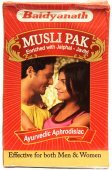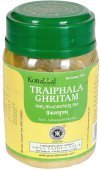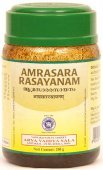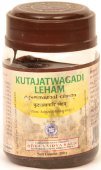Ghrita, Ghṛta: 41 definitions
Introduction:
Ghrita means something in Buddhism, Pali, Hinduism, Sanskrit, Jainism, Prakrit, Marathi, Hindi. If you want to know the exact meaning, history, etymology or English translation of this term then check out the descriptions on this page. Add your comment or reference to a book if you want to contribute to this summary article.
The Sanskrit term Ghṛta can be transliterated into English as Ghrta or Ghrita, using the IAST transliteration scheme (?).
Alternative spellings of this word include Ghrat.
In Hinduism
Ayurveda (science of life)
Rasashastra (Alchemy and Herbo-Mineral preparations)
Source: archive.org: Rasa-Jala-Nidhi: Or Ocean of indian chemistry and alchemyGhritam refers to “clarified butter”. (see Bhudeb Mookerji and his Rasajalanidhi)
Dietetics and Culinary Art (such as household cooking)
Source: Shodhganga: Dietetics and culinary art in ancient and medieval IndiaGhṛta (घृत) refers to the “clarified butter”, and is commonly found in literature dealing with the topics of dietetics and culinary art, also known as Pākaśāstra or Pākakalā.—Curds was widely used in Vedic period. Ṛgveda mentions a preparation in which the curds were mixed with Soma juice and barley meal. [...] According to Om Prakash, the cream of milk (santānikā), the cream of curds (sara), whey (mastu), fresh butter (navanīta), clarified butter (ghṛta) and the butter milk (takra) are all referred to in Ayurvedic preparations. Curds churned without water (ghola) is referred to in Suśrutasaṃhitā. [...] Later in the classical literature we can see that fresh butter (navanīta), butter prepared from the previous day’s milk (haiyaṅgavīna) and clarified butter (ghṛta) were widely referred to in. Clarified butter was considered a germicide in Matsyapurāṇa.
Ghṛta or “ghee” is mentioned in a list of potential causes for indigestion in the 17th century Bhojanakutūhala (dravyaguṇāguṇa-kathana).—A complete section in Bhojanakutūhala is devoted for the description of agents that cause indigestion [viz., ghṛta (ghee)]. These agents consumed on a large scale can cause indigestion for certain people. The remedies [viz., jambīrarasa (juice of citron) or jambharasa (extract of lemon)] for these types of indigestions are also explained therewith.
Ghṛta (ghee) is also mentioned as a remedy for indigestion caused by kadala (plantain).
Kalpa (Formulas, Drug prescriptions and other Medicinal preparations)
Source: Ancient Science of Life: Yogaśataka of Pandita VararuciGhṛta (घृत) or Ghṛtakalpanā refers to “medicated ghee”, as dealt with in the 10th century Yogaśataka written by Pandita Vararuci.—The Yogaśataka of Pandita Vararuci is an example of this category. This book attracts reader by its very easy language and formulations which can be easily prepared and have small number of herbs. It describes only those formulations (viz., ghṛta-kalpanā) which are the most common and can be used in majority conditions of diseases.
Source: Ancient Science of Life: Evaluation of Cyavanaprāśa on Health and Immunity related Parameters in Healthy ChildrenGhṛta (घृत) refers to “clarified butter”, and is used in the Ayurvedic formulation known as Cyavanaprāśa: an Ayurvedic health product that helps in boosting immunity.—Cyavanaprāśa has been found to be effective as an immunity booster, vitalizer and a preventer of day to day infections and allergies such as common cold and cough etc. It is a classical Ayurvedic formulation comprising ingredients such as Ghṛta. [...] Cyavanaprāśa can be consumed in all seasons as it contains weather friendly ingredients which nullify unpleasant effects due to extreme environmental and climatic conditions.
Source: Shodhganga: Edition translation and critical study of yogasarasamgrahaGhṛta (घृत) refers to “medicated ghee” and is a Sanskrit technical term appearing in the 15th-century Yogasārasaṅgraha (Yogasara-saṅgraha) by Vāsudeva..—Ghṛta (“medicated ghee”) is medicated clarified butter. Its preparation is similar to that of medicated oil. It is not the new ghee that is used. It should be at least one year old. Unless mentioned it is the ghee of cow that is used.
Veterinary Medicine (The study and treatment of Animals)
Source: Asian Agri-History: Paśu Āyurvēda (Veterinary Medicine) in GaruḍapurāṇaGhṛta (घृत) or Ājya refers to “ghee” and is used in the protection rites of Horses (Aśvarakṣaṇa), according to Āyurveda sections in the Garuḍapurāṇa.—For the Rakṣa (protection) Revanta-pūjā, (worship of God Revanta) homa (sacrificial offerings) and dvija-bhojana (feeding of Brahmins) should be performed in favor of the horse. And a compound made up of following drugs should be tied round the neck of the horse [e.g., ghṛta (ghee)] [...].
Toxicology (Study and Treatment of poison)
Source: Shodhganga: Kasyapa Samhita—Text on Visha ChikitsaGhṛta (घृत) or “oil” refers to one of the ten sources of plant poison, as described in the Kāśyapa Saṃhitā: an ancient Sanskrit text from the Pāñcarātra tradition dealing with both Tantra and Viṣacikitsā—an important topic from Āyurveda which deals with the study of Toxicology (Viṣavidyā or Sarpavidyā).—Kaśyapa states in the fourth Adhyāya that Śiva taught him that poisons are of five kinds viz. immobile, mobile, artificial, caused by planets and (arising out of) doubt. The sources of plant poison, ten in number are [viz. oil (ghṛta)]. The speed in which they spread too are varied (KS. XII.66):
Unclassified Ayurveda definitions
Source: Wisdom Library: Āyurveda and botanyGhṛta (घृत) is a Sanskrit technical term translating to “ghee” (clarified butter), and is used throughout Ayurvedic literature such as the Caraka-saṃhitā and Suśruta-saṃhitā. Ghee is a liquid substance obtained from the milk of cows (after process according to traditional preparations).
Source: archive.org: Vagbhata’s Ashtanga Hridaya Samhita (first 5 chapters)Ghṛta (घृत) refers to “ghee”, as mentioned in verse 5.37-39 of the Aṣṭāṅgahṛdayasaṃhitā (Sūtrasthāna) by Vāgbhaṭa.—Accordingly, “[...] [ghee is] recommended for wit, memory, intellect, digestion, strength, longevity, sperm, eyes, children, old people, those desirous of offspring, beauty, great tenderness, and voice, (and) those exhausted from pulmonary rupture, pulmonary consumption, erysipelas, scalpel, and fire; [ghee is] dispersive of wind, choler, poison, frenzy, desiccation, unbeautifulness, and fever foremost among fats, cooling, (and) a first-rate preservative of youth: ghee [viz., ghṛta] (is) possessed of a thousand powers (and), by its (many) ways of application, productive of a thousand effects”.
Note: Ghṛta (“ghee”) has been transferred to the beginning of pāda c and reproduced by źun mar (“melted butter”); cf. v. 37.
Source: eJournal of Indian Medicine: Memoirs of Vaidyas (3)Medicated ghee (ghṛta) is used both externally and internally. For small children, [medicated] ghee is given just for licking. They are not made to drink ghee. At times, [medicated] ghee is applied on the joints. This normalizes and stabilizes the movements of vāta. This is the treatment for apasmāra.
Source: gurumukhi.ru: Ayurveda glossary of termsGhṛta (घृत):—Ghee

Āyurveda (आयुर्वेद, ayurveda) is a branch of Indian science dealing with medicine, herbalism, taxology, anatomy, surgery, alchemy and related topics. Traditional practice of Āyurveda in ancient India dates back to at least the first millenium BC. Literature is commonly written in Sanskrit using various poetic metres.
Natyashastra (theatrics and dramaturgy)
Source: Wisdom Library: Nāṭya-śāstraGhṛta (घृत) is a Sanskrit word referring to ghee (clarified butter). During the ceremony of “laying the foundation” of the playhouse (nāṭyamaṇḍapa), this ghṛta should be offered to Brahmins, according to the Nāṭyaśāstra 2.41-42.

Natyashastra (नाट्यशास्त्र, nāṭyaśāstra) refers to both the ancient Indian tradition (shastra) of performing arts, (natya—theatrics, drama, dance, music), as well as the name of a Sanskrit work dealing with these subjects. It also teaches the rules for composing Dramatic plays (nataka), construction and performance of Theater, and Poetic works (kavya).
Purana and Itihasa (epic history)
Source: archive.org: Puranic EncyclopediaGhṛta (घृत).—A King of the Aṅga dynasty. He was the son of Gharman and father of Viduṣa. (Agni Purāṇa, Chapter 277).
Source: archive.org: Nilamata Purana: a cultural and literary studyGhṛta (घृत) refers to “purified butter”, forming part of a common diet in ancient Kashmir (Kaśmīra) as mentioned in the Nīlamatapurāṇa.—Ghṛta is referred to as food and unguent (verses 478, 787). Most of the references to the articles of diet occur in the Nīlamata in connection with the offerings made to the gods but it is not difficult to infer from them the food and drink of the common people because “what a man eats his gods eat”.
Source: archive.org: Shiva Purana - English TranslationGhṛta (घृत) refers to “ghee” (suitable for a marriage ceremony)”, according to the Śivapurāṇa 2.3.37 (“The letter of betrothal is dispatched”).—Accordingly, as Himavat prepared the wedding of Menā and Śiva: “[...] Then he began collecting foodstuffs and other requisite articles intended for the performance of the marriage. [...] Mountainous masses of rice, beaten rice, jaggery, sugar candies and salt were heaped up. He caused huge tanks and receptacles built for milk, ghee (ghṛta) and curds as well as for fried flour cakes of barley and other grains and ball-like sweets. Big tanks and receptacles were made for the nectar, sugarcane juice, baked cakes, and the sugar candies. [...]”.
Source: Cologne Digital Sanskrit Dictionaries: The Purana Index1a) Ghṛta (घृत).—A son of Dharma and father of Durdama.*
- * Matsya-purāṇa 48-8; Viṣṇu-purāṇa IV. 17. 4.
1b) An ocean of, surrounding Krauñcadvīpa.*
- * Brahmāṇḍa-purāṇa II. 16. 12; IV. 31. 18; Matsya-purāṇa 13. 7.

The Purana (पुराण, purāṇas) refers to Sanskrit literature preserving ancient India’s vast cultural history, including historical legends, religious ceremonies, various arts and sciences. The eighteen mahapuranas total over 400,000 shlokas (metrical couplets) and date to at least several centuries BCE.
Shaivism (Shaiva philosophy)
Source: Wisdom Library: ŚaivismGhṛta (घृत) refers to “ghee” (clarified butter). It is one of the six products of the cow, used in the worshop of the liṅga (known as goṣaḍaṅgavidhi), according to the Śivadharmottarapurāṇa
Source: Brill: Śaivism and the Tantric TraditionsGhṛta (घृत) refers to “ghee”, according to the 13th-century Matsyendrasaṃhitā: a Kubjikā-Tripurā oriented Tantric Yoga text of the Ṣaḍanvayaśāmbhava tradition from South India.—Accordingly, “[The intercourse (saṃga)]:—[...] He should dry brahmamaṇḍūkī together with its roots in the shade. He should mix it with grape-juice, candied sugar and ghee (ghṛta). He should have it three times [a day] for three months in portions measuring a dice as food and drink and he should drink milk. His semen will not deteriorate in millions of years if he practises sex [with Māyā]. His [semen] will never ever wane. It is for the rejuvenation of the body, O Priyā. [...]”.
Source: SOAS University of London: Protective Rites in the Netra TantraGhṛta (घृत) refers to “ghee” (used for worship), according to the Netratantra of Kṣemarāja: a Śaiva text from the 9th century in which Śiva (Bhairava) teaches Pārvatī topics such as metaphysics, cosmology, and soteriology.—Accordingly, [verse 10.39-45]—“[...] He worships with a mixture of white sandalwood, dust-colored powdered camphor, seeds, grain, and sesame, [mixed together] with white sugar [that has been] combined with ghee and milk (ghṛta-kṣīra-samāyukta). All meditation done with effort and volition is the highest, etc. [and] causes one to thrive, etc. If, while [performing the agreed mediation], worshiping with Mṛtyujit [in mind, the king] obtains great peace [mahāśanti] instantly”.

Shaiva (शैव, śaiva) or Shaivism (śaivism) represents a tradition of Hinduism worshiping Shiva as the supreme being. Closely related to Shaktism, Shaiva literature includes a range of scriptures, including Tantras, while the root of this tradition may be traced back to the ancient Vedas.
Dharmashastra (religious law)
Source: Sacred Texts: The Grihya Sutras, Part 2 (SBE30)Ghṛta (घृत) refers to “ hardened butter” (preferably made of the milk of cows).—According to the Aitareya-Brāhmaṇa I, 3, “Ājya is sweet or fragrant to the gods, ghṛta to men, ayuta to the manes, navanīta to children”. Here the commentator explains that ājya is butter, when melted (vilīnaṃ sarpis), ghṛta, when hardened. Ayuta, sometimes called astu, is butter, when slightly melted, niṣpakva, when thoroughly melted. According to Kātyāyana I, 8, 37, ājya is of different kinds. It may be simple ghṛta, which, as a rule, should be made of the milk of cows. But in the absence of ājya, the milk of buffaloes (māhiṣa), or oil (taila), or sesam-oil (jārtila), or linseed oil (atasīsneha), &c., may be taken.

Dharmashastra (धर्मशास्त्र, dharmaśāstra) contains the instructions (shastra) regarding religious conduct of livelihood (dharma), ceremonies, jurisprudence (study of law) and more. It is categorized as smriti, an important and authoritative selection of books dealing with the Hindu lifestyle.
Vaishnavism (Vaishava dharma)
Source: Pure Bhakti: Arcana-dipika - 3rd EditionGhṛta (घृत) refers to “ghee” and represents one of the “five ambrosial ingredients” (Pañcāmṛta), used on special occasions for bathing śrī-guru or the deity), according to the Arcana-dīpikā (manual on deity worship).—Accordingly, while explaining mantras to sanctify the Pañcāmṛta Ingredients (pañcāmṛta-śodhana-mantras), for ghee (ghṛta):—“ghṛtapāvānaḥ pibata vasāṃ vasā pāvanā pivatāntarīkṣasya havir asi svāhā. diśaḥ pradiśa ādiśo vidiśa uddiśo digbhyaḥ svāhā”.

Vaishnava (वैष्णव, vaiṣṇava) or vaishnavism (vaiṣṇavism) represents a tradition of Hinduism worshipping Vishnu as the supreme Lord. Similar to the Shaktism and Shaivism traditions, Vaishnavism also developed as an individual movement, famous for its exposition of the dashavatara (‘ten avatars of Vishnu’).
Shaktism (Shakta philosophy)
Source: Google Books: ManthanabhairavatantramGhṛta (घृत) refers to “clarified butter”, according to the Manthānabhairavatantra, a vast sprawling work that belongs to a corpus of Tantric texts concerned with the worship of the goddess Kubjikā.—Accordingly, “If a conflagration without a fire (that starts it) begins suddenly in a village, the offering of beef into the Triangle with clarified butter [i.e., ghṛta] a million times (brings about) great peace and that prevails over the whole earth”.

Shakta (शाक्त, śākta) or Shaktism (śāktism) represents a tradition of Hinduism where the Goddess (Devi) is revered and worshipped. Shakta literature includes a range of scriptures, including various Agamas and Tantras, although its roots may be traced back to the Vedas.
Jyotisha (astronomy and astrology)
Source: Wisdom Library: Brihat Samhita by VarahamihiraGhṛta (घृत) refers to “ghee”, according to the Bṛhatsaṃhitā (chapter 16) (“On the planets—graha-bhaktiyoga”), an encyclopedic Sanskrit work written by Varāhamihira mainly focusing on the science of ancient Indian astronomy astronomy (Jyotiṣa).—Accordingly, “[...] Mercury also presides over painters, grammarians, mathematicians, physicians, sculptors, spies, jugglers, infants, poets, rogues, tale-bearers, black-magicians, messengers, eunuchs, buffoons, sorcerers and conjurers; over sentinels, dancers and dancing masters; over ghee (ghṛta), gingelly and other oils; over seeds, over bitter flavour, over observers of religious ceremonies, over chemists and mules”.

Jyotisha (ज्योतिष, jyotiṣa or jyotish) refers to ‘astronomy’ or “Vedic astrology” and represents the fifth of the six Vedangas (additional sciences to be studied along with the Vedas). Jyotisha concerns itself with the study and prediction of the movements of celestial bodies, in order to calculate the auspicious time for rituals and ceremonies.
Yoga (school of philosophy)
Source: ORA: Amanaska (king of all yogas): A Critical Edition and Annotated Translation by Jason BirchGhṛta (घृत) refers to “ghee”, according to the Amanaska Yoga treatise dealing with meditation, absorption, yogic powers and liberation.—Accordingly, as Īśvara says to Vāmadeva: “[...] [Now], I shall define the nature of that highest, mind-free absorption which arises for those devoted to constant practice. [...] Just as ghee (ghṛta) which has dissolved into [another batch of] ghee, is not separate [in any way] from [that] ghee, so the Yogin, who has dissolved into the highest reality, is not aware of separateness. [...]”.

Yoga is originally considered a branch of Hindu philosophy (astika), but both ancient and modern Yoga combine the physical, mental and spiritual. Yoga teaches various physical techniques also known as āsanas (postures), used for various purposes (eg., meditation, contemplation, relaxation).
In Buddhism
General definition (in Buddhism)
Source: Wisdom Library: Dharma-samgrahaGhṛta (घृत, “buttery”) or Ghṛtasāgara refers to one of the “seven oceans” (sāgara) as defined in the Dharma-saṃgraha (section 126). The Dharma-samgraha (Dharmasangraha) is an extensive glossary of Buddhist technical terms in Sanskrit (e.g., ghṛta). The work is attributed to Nagarjuna who lived around the 2nd century A.D.
In Jainism
General definition (in Jainism)
Source: archive.org: Economic Life In Ancient India (as depicted in Jain canonical literature)Ghṛta (घृत) refers to “clarified butter” and is one of the four products of milk (gorasa). Dairy farming was carried on in a big way in ancient India. There were large cow-sheds (gomaṇḍava or gomaṇḍapa) where the herds of cows, bulls and calves were kept. There was abundant supply of milk (dugdha or khira) and its four products (gorasa) viz. curd (dadhi), butter milk (udasi or maṭṭhā), butter (ṇavaṇiya or navanīta), clarified butter or ghee (ghṛta or ghaya). Milk and milk products were available in plenty at the dairy (dohaṇa-vāḍaga). The products were stored in ‘khira sālā’. Many articles of daily food were prepared with the help of milk and its products. People could get highly nutritious food because of the easy and large supply of the dairy products.
Source: archive.org: Jaina YogaGhṛta (घृत, “ghee”) refers to one of the ten classifications of food (āhāra), also known as vikṛtis, according to the 12th century Yogaśāstra (verse 3.130) by Hemacandra. Ghṛta may be from cow’s, buffalo’s, goat’s or sheep’s milk, but not from camel’s milk.

Jainism is an Indian religion of Dharma whose doctrine revolves around harmlessness (ahimsa) towards every living being. The two major branches (Digambara and Svetambara) of Jainism stimulate self-control (or, shramana, ‘self-reliance’) and spiritual development through a path of peace for the soul to progess to the ultimate goal.
Languages of India and abroad
Marathi-English dictionary
Source: DDSA: The Molesworth Marathi and English Dictionaryghṛta (घृत).—n (S) Clarified butter, ghee.
Source: DDSA: The Aryabhusan school dictionary, Marathi-Englishghṛta (घृत).—n Clarified butter, ghee.
Marathi is an Indo-European language having over 70 million native speakers people in (predominantly) Maharashtra India. Marathi, like many other Indo-Aryan languages, evolved from early forms of Prakrit, which itself is a subset of Sanskrit, one of the most ancient languages of the world.
Sanskrit dictionary
Source: DDSA: The practical Sanskrit-English dictionaryGhṛta (घृत).—a. [ghṛ-kta]
1) Sprinkled.
2) Illumined.
-tam 1 Ghee, clarified butter; (sarpirvilīnamājyaṃ syād ghanībhūtaṃ ghṛtaṃ bhavet Sāy.).
2) Butter.
3) Water.
4) Spirit, energy (tejas); मधुच्युतो घृतपृक्ता विशोकास्ते नान्तवन्तः प्रतिपालयन्ति (madhucyuto ghṛtapṛktā viśokāste nāntavantaḥ pratipālayanti) Mahābhārata (Bombay) 1.92.15.
Source: Cologne Digital Sanskrit Dictionaries: Shabda-Sagara Sanskrit-English DictionaryGhṛta (घृत).—mfn.
(-taḥ-tā-taṃ) 1. Sprinkled. 2. Illumined. n.
(-taṃ) 1. Ghee, clarified butter, or butter which has been boiled gently, and allowed to cool: it is then used for culinary and religious purpose and is highly esteemed by the Hindus. 2. Water. f.
(-tā) The name of a tree: see ghṛtamaṇḍā. E. ghṛ to sprinkle Unadi affix kta.
Source: Cologne Digital Sanskrit Dictionaries: Benfey Sanskrit-English DictionaryGhṛta (घृत).—[ghṛ + ta] (properly ptcple. of the pf. pass. of 1. ghṛ), n. 1. Clarified butter, or butter which has been bolled gently and allowed to cool, [Mānavadharmaśāstra] 11, 134. 2. (ved.) Rain,
Ghṛta (घृत).—[neuter] clarified butter, ghee; butter, fat i.[grammar] ([especially] as emblem of fertility).
Source: Cologne Digital Sanskrit Dictionaries: Monier-Williams Sanskrit-English Dictionary1) Ghṛta (घृत):—[from ghṛ] 1. ghṛta mfn. sprinkled, [cf. Lexicographers, esp. such as amarasiṃha, halāyudha, hemacandra, etc.]
2) [v.s. ...] n. ([gana] ardharcādi) ghee id est. clarified butter or butter which has been boiled gently and allowed to cool (it is used for culinary and religious purposes and is highly esteemed by the Hindūs), fat (as an emblem of fertility), fluid grease, cream, [Ṛg-veda; Vājasaneyi-saṃhitā; Atharva-veda] etc.
3) [v.s. ...] (= udaka) fertilizing rain (considered as the fat which drops from heaven), water, [Naighaṇṭuka, commented on by Yāska i, 12; Nirukta, by Yāska vii, 24]
4) [v.s. ...] m. Name of a son of Dharma (grandson of Anu and father of Duduha), [Harivaṃśa 1840]
5) Ghṛtā (घृता):—[from ghṛta > ghṛ] f. a kind of medicinal plant, [cf. Lexicographers, esp. such as amarasiṃha, halāyudha, hemacandra, etc.]
6) Ghṛta (घृत):—[from ghṛ] 2. ghṛta mfn. ([Pāṇini 6-4, 37; Kāśikā-vṛtti]) illumined, [cf. Lexicographers, esp. such as amarasiṃha, halāyudha, hemacandra, etc.]
7) a See √1. and √2. ghṛ.
Source: Cologne Digital Sanskrit Dictionaries: Yates Sanskrit-English DictionaryGhṛta (घृत):—(taṃ) 1. n. Ghee, clarified butter; water. (tā) f. Name of a tree. a. Sprinkled; illumined.
Source: DDSA: Paia-sadda-mahannavo; a comprehensive Prakrit Hindi dictionary (S)Ghṛta (घृत) in the Sanskrit language is related to the Prakrit words: Ghaya, Ghia, Hia.
[Sanskrit to German]
Sanskrit, also spelled संस्कृतम् (saṃskṛtam), is an ancient language of India commonly seen as the grandmother of the Indo-European language family (even English!). Closely allied with Prakrit and Pali, Sanskrit is more exhaustive in both grammar and terms and has the most extensive collection of literature in the world, greatly surpassing its sister-languages Greek and Latin.
Hindi dictionary
Source: DDSA: A practical Hindi-English dictionaryGhṛta (घृत) [Also spelled ghrat]:—(nm) ghee.
...
Kannada-English dictionary
Source: Alar: Kannada-English corpusGhṛta (ಘೃತ):—[adjective] scattered in drops or particles upon; sprinkled.
--- OR ---
Ghṛta (ಘೃತ):—
1) [noun] butter which has been boiled gently and allowed to cool, and strained, used in cooking or mixing with food and for religious purposes; clarified butter.
2) [noun] water.
3) [noun] milk.
4) [noun] the food of gods; ambrosia.
5) [noun] intense enthusiasm, as in working for a cause; ardent endeavour or devotion; zeal.
6) [noun] any medicinal preparation made and preserved in clarified butter.
Kannada is a Dravidian language (as opposed to the Indo-European language family) mainly spoken in the southwestern region of India.
See also (Relevant definitions)
Starts with (+136): Ghrita-gandha, Ghritabara, Ghritabdhi, Ghritabha, Ghritabhajana, Ghritabhrishta, Ghritabhyakta, Ghritabuddhi, Ghritacala, Ghritacaladanapaddhati, Ghritachi, Ghritachigarbhasambhava, Ghritachyuta, Ghritaci, Ghritacigarbhasambhava, Ghritacigarmasambhava, Ghritacyuta, Ghritadanapaddhati, Ghritadanavidhi, Ghritadhara.
Ends with (+55): Abhighrita, Aghrita, Agnighrita, Ardrakaghrita, Ashtamangalaghrita, Avighrita, Bhringarajaghrita, Bindughrita, Brahmighrita, Brahmighrita, Chemparattighrita, Dashamulaghrita, Dashasvarasaghrita, Dhanvantaraghrita, Drakshaghrita, Ekanayakaghrita, Gavyaghrita, Goghrita, Guggulutiktakaghrita, Indukantaghrita.
Full-text (+516): Goghrita, Sarpis, Ghritahva, Ghritakumari, Ghritavara, Ghritapura, Ghritaprashana, Ghritamanda, Ghritahuti, Ghritapluta, Ghritavani, Ghritin, Ghritakta, Ghritaprasatta, Ghritapashu, Ghritapa, Ghritapadi, Ghritavridh, Ghritaduh, Ghritasprish.
Relevant text
Search found 71 books and stories containing Ghrita, Ghṛta, Ghrta, Ghṛtā; (plurals include: Ghritas, Ghṛtas, Ghrtas, Ghṛtās). You can also click to the full overview containing English textual excerpts. Below are direct links for the most relevant articles:
Rig Veda (translation and commentary) (by H. H. Wilson)
Garga Samhita (English) (by Danavir Goswami)
Verse 1.17.17 < [Chapter 17 - Description of the Yogurt Theft]
Verse 1.17.19 < [Chapter 17 - Description of the Yogurt Theft]
Vakyapadiya of Bhartrihari (by K. A. Subramania Iyer)
Verse 2.86 < [Book 2 - Vākya-kāṇḍa]
Verse 3.14.483 < [Book 3 - Pada-kāṇḍa (14): Vṛtti-samuddeśa (On Ccomplex Formation)]
Verse 2.345 < [Book 2 - Vākya-kāṇḍa]
Charaka Samhita and Sushruta Samhita (by Nayana Sharma)
Bhūtas and Grahas < [Chapter 8]
Denial of Treatment < [Chapter 4]
Processing of medicines < [Chapter 7]
Manusmriti with the Commentary of Medhatithi (by Ganganatha Jha)
Verse 10.88 < [Section IX - Variations in the Functions of the Brāhmaṇa due to Abnormal Conditions]
Verse 2.107 < [Section XX - Non-observance of Holidays]
Verse 12.62 < [Section IX - Details of Transmigration]
Sushruta Samhita, volume 4: Cikitsasthana (by Kaviraj Kunja Lal Bhishagratna)
Related products
(+15 more products available)





